Archive for the ‘Caryocar costaricense’ Tag

The transition from the wet into the dry season is normally marked by a variety of changes that are both easy to see and hear. So far those changes have not been that obvious for 2017. The unusually heavy rains during November and December last year would appear to have delayed, if not completely altered a lot of plant and animal behaviors. But now, some two months after expecting to see certain changes, they are beginning to take place.
There has been a late start to the flowering season for many trees. This week some of the trees that would have been expected to flower in December are now flowering in February. One notable example is the Ajo Tree, (Caryocar costarincensis). Its bright lemon yellow blooms can now be seen littering the forest floor on many of the trails. Take a trip up into the tree tops on the canopy platform and you will find many species of tree crowns covered in flowers. This is turn attracts many butterflies and they can be seen flying from flower to flower, tree to tree, all around the sunlit forest canopy.

Ajo Tree, (Caryocar costaricensis). Flowers.
Rain forests in general can be windless areas. The forests of the Osa Peninsula experience very little wind except when a heavy rain approaches pushing a pocket of air in front of it. The plants therefore have to rely for the most part on animals to carry out both pollination and seed dispersal. Bats are very important pollinators and seed dispersers. Bats prefer musky odors to sweet odors. This results in the plants emitting various scents that humans would not be expecting, being used to the more fragrant sweet smell of flowers. The bats however are attracted by the scent of garlic. The nectar feeding bats have a long muzzle and a long sticky tongue. While they are feeding on the nectar, the long anthers of the flower dust pollen over the head and shoulders of the bat which then flies off to visit another flower transferring the pollen and effecting pollination.
In subtle contrast to the green of the hedgerow vegetation are the strong purples of the Morning Glory, (Ipomea) which are currently flowering. This is a vine which wends its way through the hedges. The purple color is attractive to insects. The flowers prefer the full sun despite the name “Morning Glory” which refers to the flowers unfurling at first light of dawn.

Morning Glory, (Ipomoea sp)
The butterflies are starting to be seen in greater numbers but the levels fall a long way short of what would be expected at this time of year. The height of the butterfly season is between February and March but so far the visible populations, particularly of some species, are noticeably down.
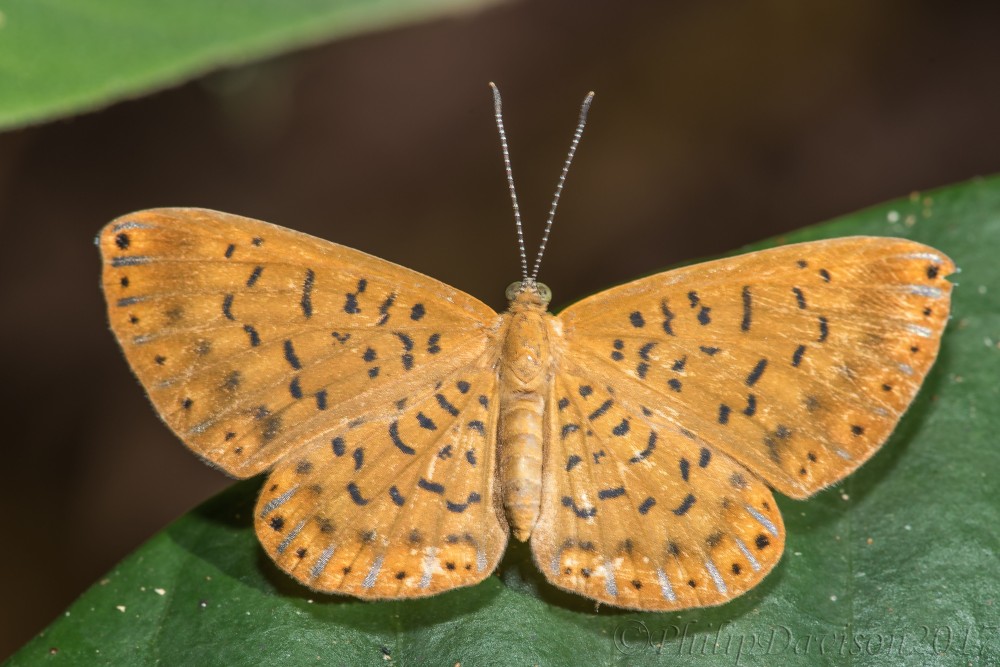
Metacharis victrix
At night the number of amphibians is starting to diminish. For some time now the number of species has reduced to 4 or 5 but the number of individuals of each species has dwindled to only one or two hopeful males calling for a mate. It is highly unlikely that there will be a response at this time of year. The Savage’s Thin-fingered Frogs, (Leptodactylus savagei), are increasing slightly in numbers around the pond. As the area continues to dry the pond is the only damp refuge and these large amphibians start to congregate around the pond edge sometimes entering the water where they can be found floating.
Floral Descent
Whereas many of the plants have been slow to flower, some of the orchids have not.. To see the orchids you generally need to up in the forest canopy, 88% of the Costa Rican orchids are epiphytic, they are up at the top of the trees. But occasionally you may be lucky to see some that have found a suitable location nearer to the ground. When not in bloom it is easy to miss them as many orchids have small insignificant flowers, but not all, others when in flower can have quite a showy display. Orchidaceae is a very species rich family of flowering plants rivalled only by the Asteraceae or daisy family in terms of numbers. Being so diverse makes them hard to identify. Many people admire them for their aesthetic, if sometimes subtle, beauty. They are therefore a group of greater interest to orchid specialists in terms of identification and geographical distribution. Equaled by the diversity of species and form of the flowers are the number of ways in which orchids become pollinated. Some of them have evolved means of attracting pollinators that would seem to be, on first reading, the stuff purely of science fiction.
Around the gardens and forests there are orchids that are slightly more obvious. Growing on some of the garden trees as epiphytes are the white-flowered, night-perfumed Lady of the Night, (Brassavola nodosa). At night the white flowers give off a heavy sweet perfume that attracts in hawkmoths. The moths hover in front of the flower and using the long proboscis probe for nectar. While doing so they become covered in pollen which is then transferred to the next flower they visit. Not too far away growing in the borders are the Bamboo Orchids, (Arundina graminifolia). This is a terrestrial orchid native to south east Asia. It is however widely grown in Costa Rican gardens. The purple bee pollinated blooms are born on long thin stems that resemble a bamboo stem.
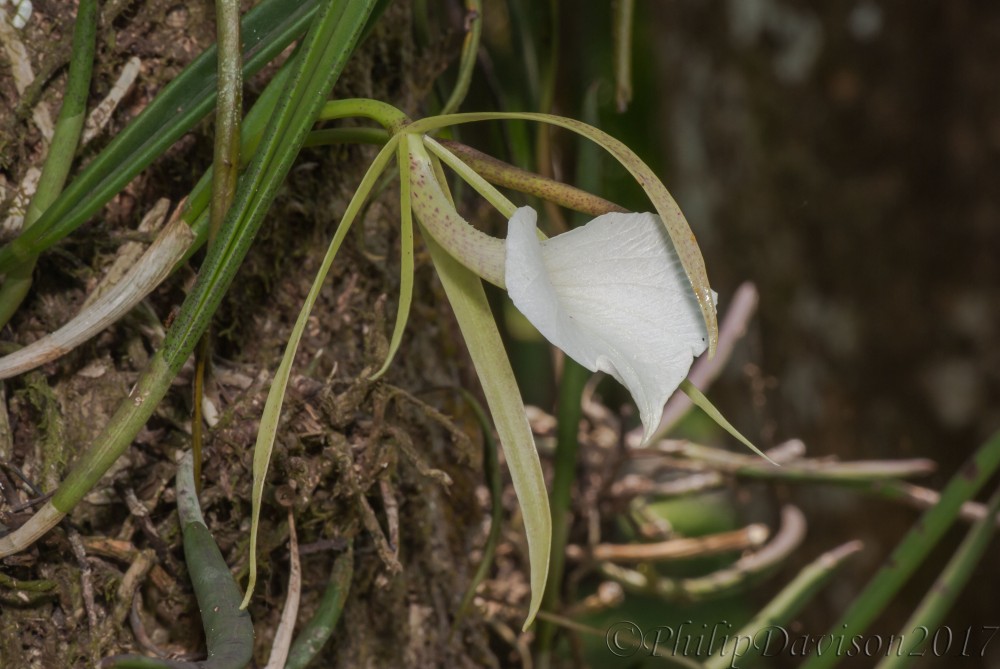
Lady of the Night, (Brassavola nodosa)
On the forest trails growing low down and in locations near to water you may find, (Stanhopea cirrhata). Stanhopea species emit an scent that attracts certain species of orchid bee. The males gather the scent which they mix with other plant volatiles to produce their own perfumes. The structure of the Stanhopea orchid is such that while the bee is gathering the scent a pollen package is attached to the bee which unwittingly transfers it to the next orchid it visits.
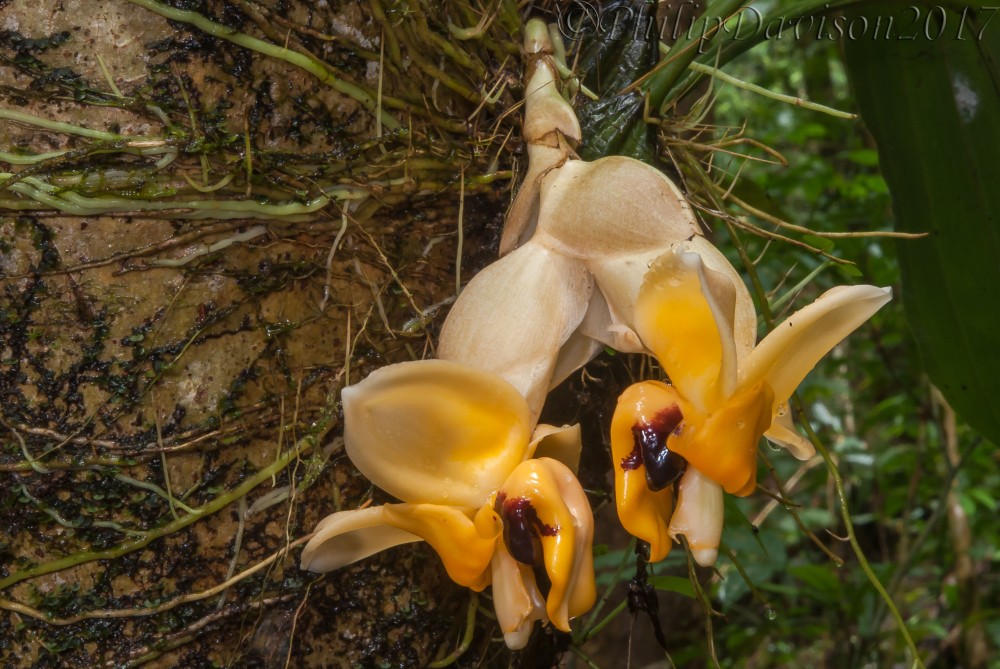
Stanhopea cirrhata
There are some orchids whose flowers are as green as their leaves. Numbering amongst them is the Vanilla Orchid, (Vanilla planifolia). In the wild Vanilla orchids are pollinated by orchid bees but when commercially grown and pollinated by hand. Growing on the sides of trees are some of the green flowered Epidendrum Orchids. There are about 160 species of Epidendrum in Costa Rica which makes them a little difficult to identify.
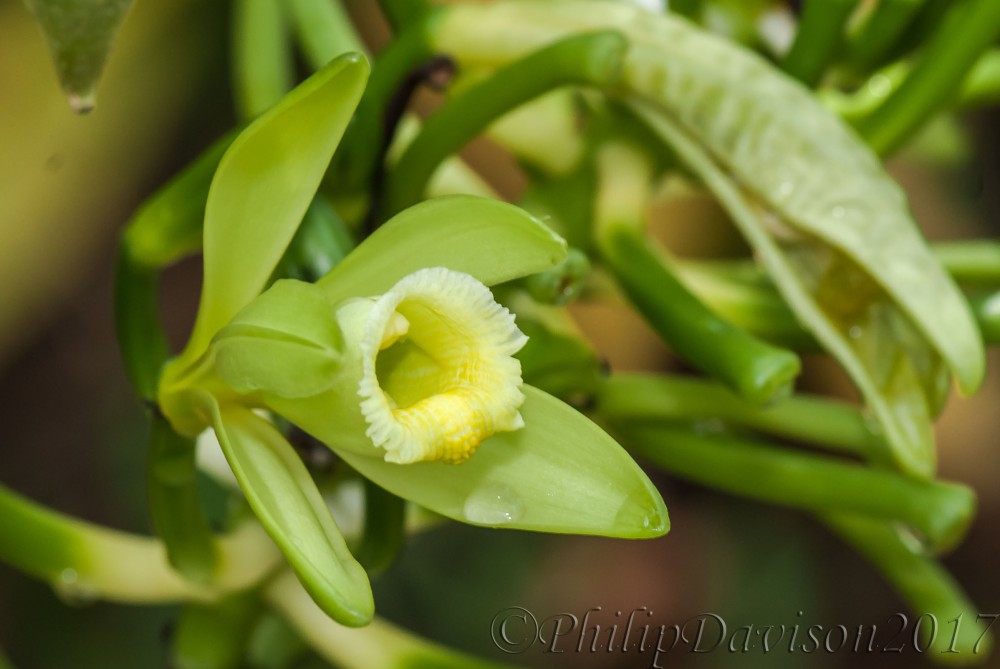
Vanilla Orchid, (Vanilla planifolia)
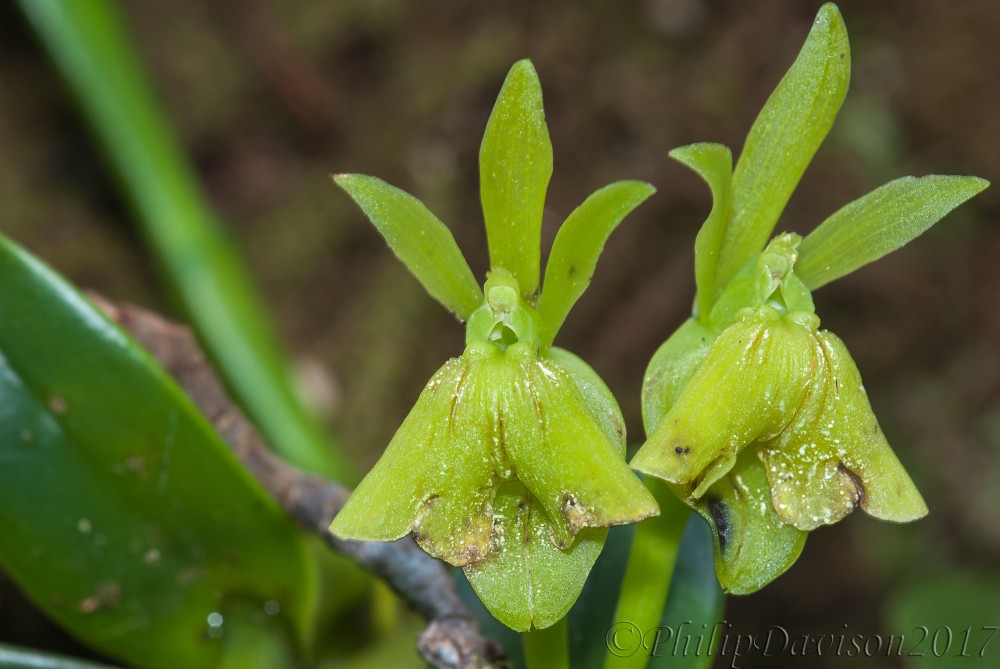
Epidendrum sp
Dragons and Damsels
If you spend enough time by any body of water around the grounds then you are likely to see some of the Odonates; dragonflies and damselflies. The dragonflies can more commonly be found still bodies of water such as the pond whereas the damselflies seem to frequent areas closer to running water such as the creek. They can also be seen in the gardens and throughout the forest too. You can tell a dragon from a damsel when they land as the dragonflies perch with the wings out to the sides whereas the damselflies perch with the wings folded together over the back.
You have to have patience to photograph dragon and damselflies. They react to the slightest movement near them by taking to the air. They do have favored perches though so if you set the camera up on a tripod or simply rest in a comfortable position, camera in hand, they well almost always return in short time and alight at the place from which they took off.
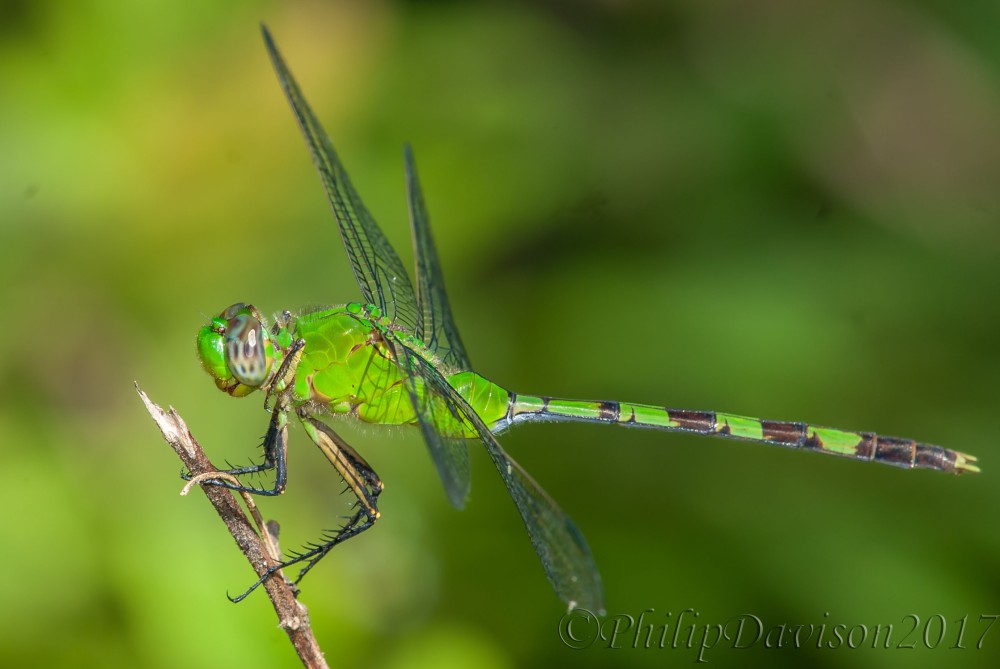
Great Pondhawk, (Erythemis vesiculosa)

Red-mantled Dragonlet, (Erythrodiplax fervida)
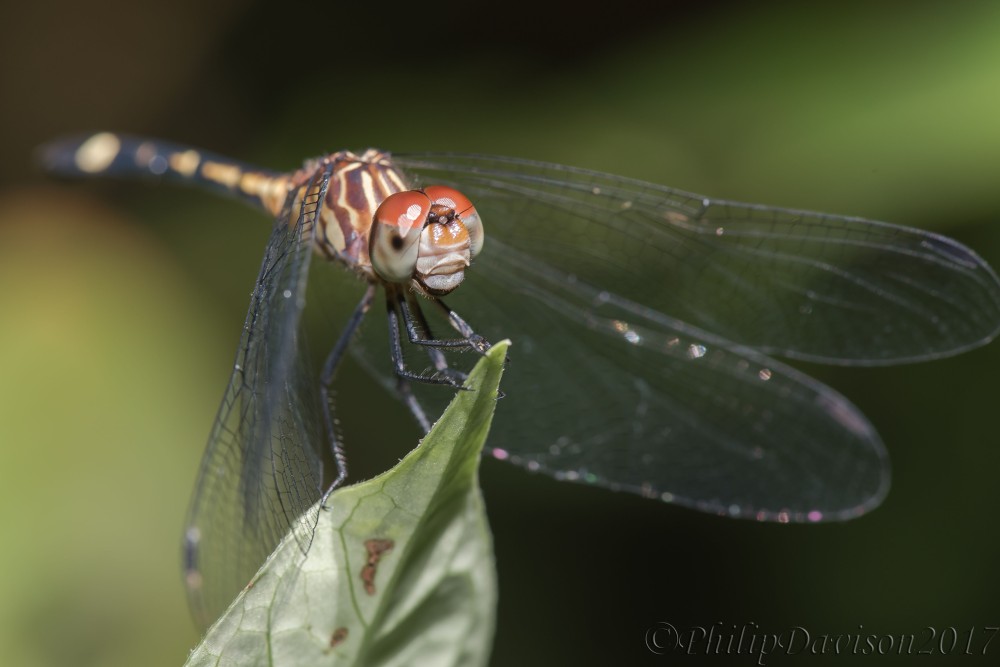
Three-striped Dasher, (Micrathyria didyma)
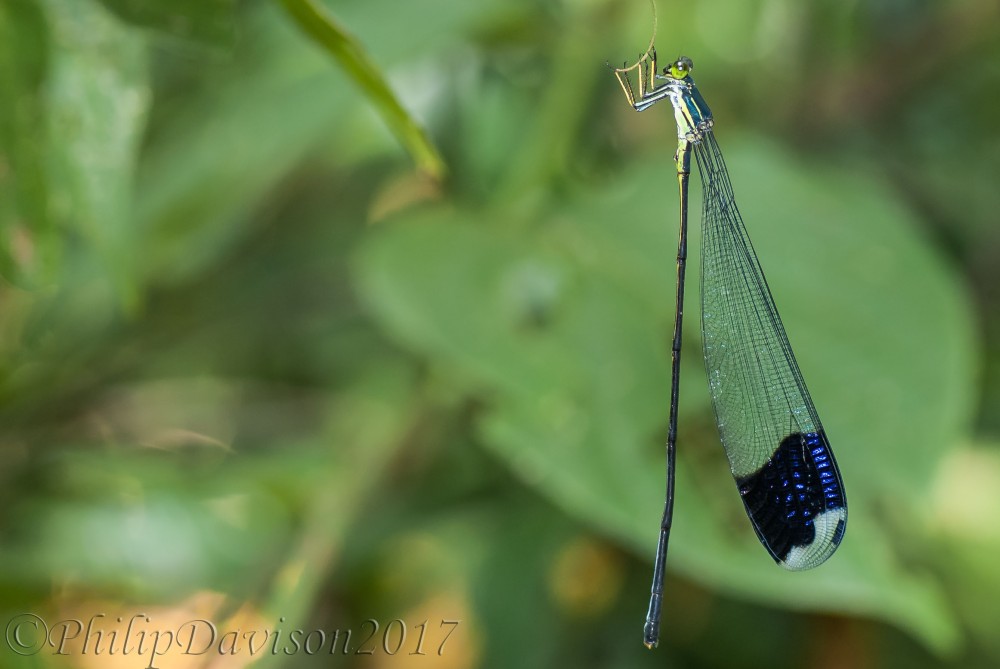
Helicopter Damselfly, (Megaloprepus caerulatus)
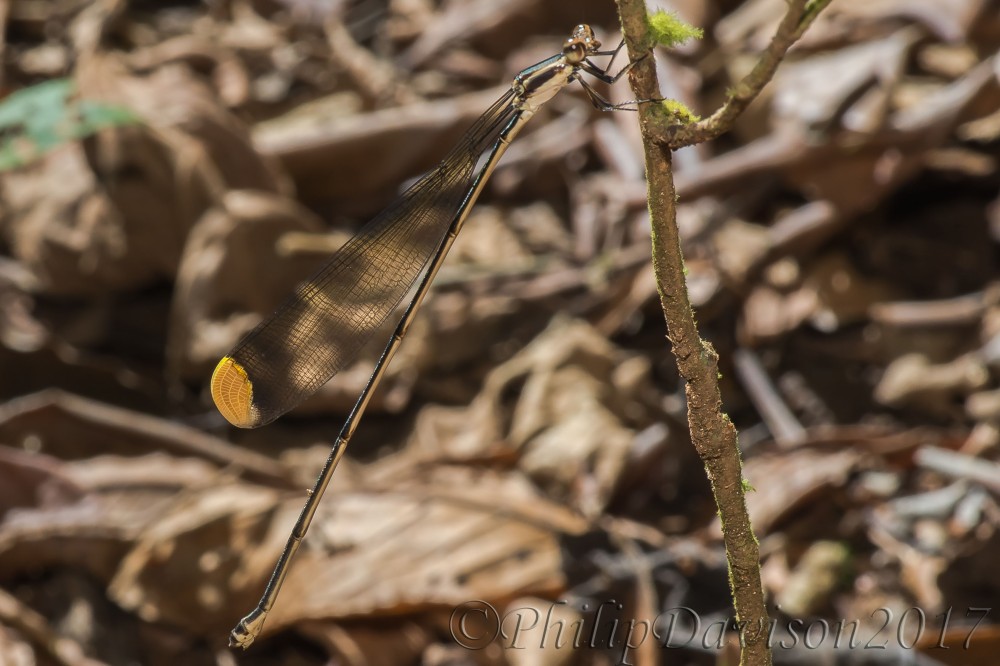
Ornate Helicopter Damselfly, (Mecisogaster ornata)
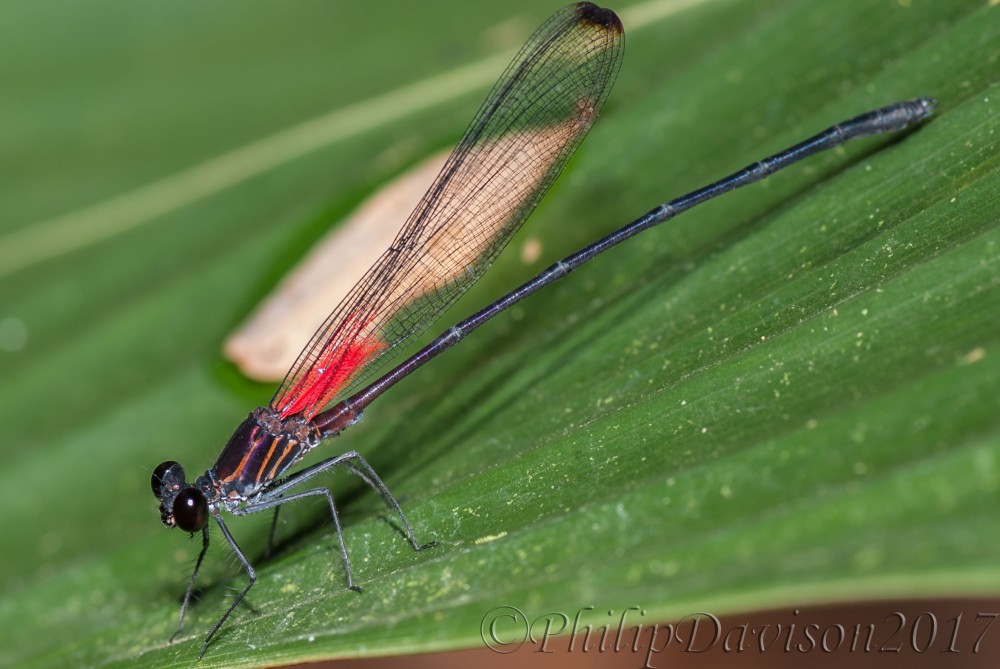
Hetaerina orissa
Philip Davison is a Biologist, Writer and Photographer Based in Costa Rica

Tuesday 2nd February 2016
Senna to Sleep
Over the past few weeks many of the trees have started to flower. The increasingly dry conditions stimulate blooming at this time of the year but because most of the floors are 100 foot up in the forest canopy then the only time the visitor has to see them is when flying over the forest or when the spent blooms fall to the ground and lie littering the forest floor amongst the dry leaves. However there are some smaller trees, shrubs and herbaceous plants that grow beneath the canopy or in more open conditions. Here you can get to see the floral display at a closer proximity.
One of those small trees generally found growing along sunny paths and roads is the Saragundi, (Senna reticulata). Its bright yellow flowers tinged with a hint of orange stand upright like fat golden candles giving the whole of the tree crown an overall fiery glow against the green background of the forest or azure blue of the sky. Stand beneath the tree and you will hear the constant buzz of bees attracted by its flowery display as they come to take nectar and pollen.
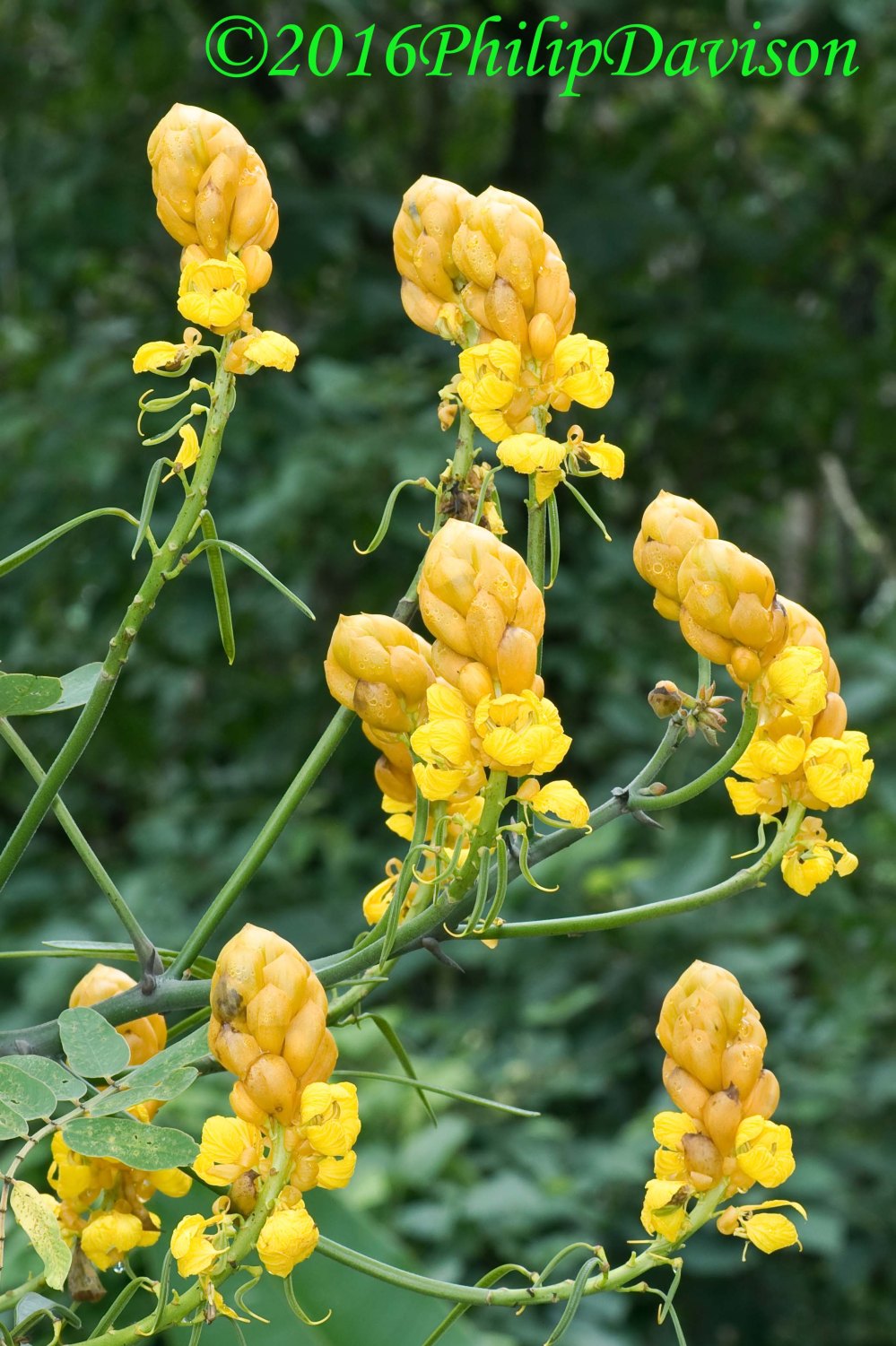
Despite its showy appearance Saragundi is not a welcome part of the native flora as far as farmers are concerned. It is a rapidly growing weedy tree that will quickly invade and take over open areas such as pasture land and nor is it easy to eradicate. It is little wonder that the local gardening team around here hates them with a vengeance and cut them down as soon as they germinate.
Should you see a Saragundi later in the day, more towards dusk, you will notice that the leaves start to droop and the plant goes to “sleep.” This is a feature common to many plants in the Fabacaea family, (legumes), and it is known as a nastic response. The base of each leaflet has a fleshy elbow called a pulvinus. During the course of the day the rhythmic flow of potassium ions causes water to either enter or exit the cells of the pulvinus. In the morning the large water holding cells become full of water making the pulvinus turgid which holds the leaflet out straight. At dusk water exits the cells making the pulvinus flacid and so the leaflet folds down appearing as if to go to sleep. It is not known what evolutionary benefit this nyctinasty conveys on the plant but it most certainly looks like some of the forest trees are dozing off for the evening.
A Rod of Gold
Growing along the currently dusty roadsides or lining the forest edge abutting the gardens are weedy long-stemmed plants that have a crown of yellow flowers atop. These are the Jackass Bitters, (Nuerolaena lobata). It belongs to the Aster family which includes the daisies and dandelions. It is one of the most species rich families of plants on the planet rivaled only by that of the orchids.
The flowers heads are composites; each individual head is a group of flowers, the greater display of many flowers together provide a more attractive visual target to potential pollinators.

There is a lot of folk medicine currently based on the supposed curative properties of Jackass Bitters but none that has any scientific backing. However its anti diabetic qualities are being scrutinized in a laboratory situation with regards to its ability to exert some control over blood sugar levels.
Canna Look at Your Lily
Tucked under the shady conditions beneath the taller vegetation where the garden meets the forest edge are a low growing plant with yellow flowers. These are the Canna Lilies, (Canna x generalis). It is mostly a hybridized form cultivated to bring a splash of color to leafy green flower borders. It is not obvious from which natural species of Canna that this variety has been hybridized but it is possible that it may be a Neotropical native Indian Shot, (Canna indica). You will seeing this variety growing freely in many garden situations around the country.

Going Bats for Garlic
Going for a walk through the forest this time of year may certainly cause a stimulation of your olfactory senses. There are many scents and odors that seem vaguely familiar but you cannot quite put bring to mind what it is simply because it out of context. Currently walking through the forest there are areas where you experience the definite smell of chives, or is it onions, no wait a minute it is garlic. What would garlic be doing growing in a tropical rain forest situation?
Here and there along the forest trail there are patches of yellow flowers littering the forest floor en masse. At this point the aroma of garlic is very strong. The flowers lie for some distance concentrically around the base of a large tree which given its appearance looks more like a tree from higher temperate forests. The bark is rough and deeply fissured, closely resembling an Oak Tree than a smooth bark tropical tree. This is the Ajo or Garlic Tree, (Caryocar costaricense), so named because its flowers give off a scent reminiscent of garlic.

There is very little wind in the Pacific lowland forests of Costa Rica so the plants have to rely on animal agents for pollination and seed dispersal. Bats are very important pollinators and seed dispersers but bats prefer musky smells rather that sweet smells which is why there are some very strange odors in the forest. It is the scent of garlic that attracts the bats in so the Garlic Tree is a bat pollinated tree.
Seeing Things in a Different Light
On the hot sunny days of the dry season many butterflies can be seen flying around the garden areas. There are several species that are noticeable due to their striking yellow coloration. These could be the “butter” flies. These are the sulphurs and they are not easy to tell apart species wise unless you have them in the hand.
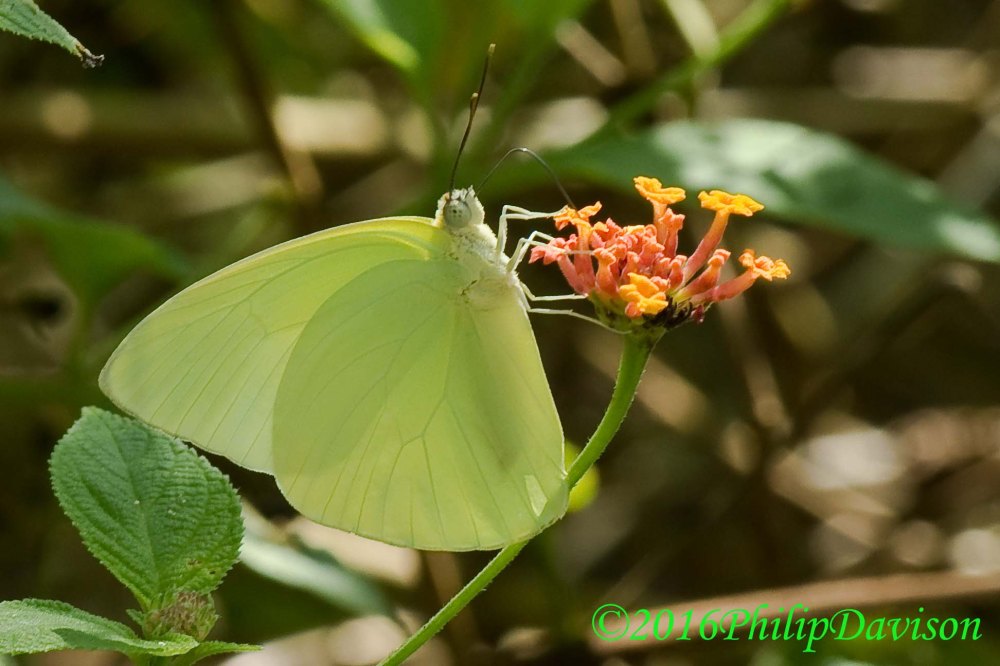
Sulphur butterflies belong in the Subfamily: Coliadinae of the family: Pieridae. To the human eye the butterflies all have yellow coloration to a greater or lesser extent. Some may appear to be more creamy-yellow, others lemon yellow and yet others orangey-yellow but without exception – yellow, hence the name sulphur. But that is not how they look to other butterflies.

Butterflies, unlike humans see light at the ultraviolet wavelength of the electromagnetic spectrum. The dorsal surface of the male sulphurs wings are colored with a yellow pigment. This re-enforces a reflective ultra violet component that covers most of the dorsal wing surface and appears to sexually attractive to females which only have a small amount of ultra violet reflectance on their wings in comparison. The ultra violet patterning is used by the males in courtship displays. To human eyes the butterfly appears as a dancing honey colored piece of confetti. The females however see something different. Larger males with bright reflective radiance appear to be more attractive to larger females. In the world of the sulphurs flashy show offs get the girls.
Philip Davison is a biologist, writer and photographer based in Costa Rica.
Felipe del Bosque Blog April 15th 2013

Water Music
There has been a little more rain falling over the course of the past week. More particularly there was one night with more rain than has been experienced recently. It rained all night at a steady light drizzle and that was enough to dampen the trails and refresh the plants. It also served to fool the frogs which burst into action thinking the summer had ended. The night following the rain the Milky Frogs, (Trachycephala venulosa) came out in huge numbers. The sound of their calls could be heard from some distance which upon approaching the pond became deafening. The grassy areas away from the pond were the scene of an exodus by Savage’s Thin-fingered Frogs, (Leptodactylus savegei), whose patience had been tried by their noisy cousins and were consequently moving off to quieter and less boisterous locations.

The males were out in force. Wherever you looked there were calling frogs. They were calling from the vegetation above the pond and most numerously in the water. They were grabbing hold of anything that came near in the hope that it was a female. Enough of the males must have found a female because the following morning the pond surface was covered with Milky Frog eggs. These frogs must take advantage of short term breeding pools because the tadpoles develop into the free swimming stage overnight. In two days the pond was filled with a writhing black mass of tadpoles.

The crabs are always stimulated into action during the dry season if there has been even the slightest amount of precipitation. Having had several nights of light rain the forest floor has been alive with crab activity. But following two or three days of drying weather they disappear down their burrows once again.
Pigging Out On Cats
There has been one cat spotted on the grounds of the lodge last week. A female Puma, (Puma concolor), was seen on the driveway by the Titi Trail entrance. It was mid afternoon and she was just standing at the side of the road oblivious to the presence of humans passing by.
The small herd of White-lipped Peccary, (Tayassu pecari), is still wandering the grounds. They have been in the same location for five weeks now so it could be that they are going to stay. They regularly pass by the front of the restaurant on their way to the Pacific Trail where there is a fig tree fruiting. There is a lot of monkey activity in this particular tree and with monkeys being wasteful feeders they are throwing a shower of half eaten fruits to the ground which is keeping the peccaries well fed.
There has also been another fig tree fruiting in front of the cabins near the restaurant. This has resulted in daily influxes of different species of monkey, some of which are all in the same tree at the same time, presenting some easily accessible and wonderful photographic opportunities.
The Western Red Bats, (Lassiurus blossivillii), are still roosting between the dried leaves of the thatch. Last week one female was observed with two baby bats suckling. The Tent-making Bats, (Uroderma bilobatum), have also been seen under several tents that have recently been created near the restaurant area.

Hanging out At The Pond

With the sun still shining brightly on a daily basis the water from the pond has been progressively evaporating. With no rain to replenish the volume, the water level has dropped. The vegetation sitting on the surface of the water and surrounding it at the back provide perfect perches for the dragonflies and there are always several species present in greater or lesser numbers. There are two large red species, the Roseate Skimmer, (Orthemis ferruginea), and a king skimmer, (Libellula herculea), that take the prime upper landing spots, chasing away anything that dares to try and usurp their positions. There is a smaller species, blue in color, a tropical dasher, (Micrathyria ocellata), which prefers to establish itself on the lower growing vegetation. If you sit and watch you will see the dragonflies land, rest and then quickly take to the air, hovering over the water ready to chase off any other individual invading their space or ready to snatch an unsuspecting meal from the air.

Katydids always make fascinating subjects due to their multifarious forms and colors. They all have the distinctive katydid shape which is not too dissimilar to the grasshoppers and crickets t which they are closely related. It is the divergence from that general body plan that makes them so compelling.



Many of the katydids are green in color and resemble the vegetation in which they can be found feeding. Then there is a movement away from simply mimicking the color of the surrounding leaves into more elaborately disguised forms. The wings start to take on the distinct appearance of the leaves themselves, veins and all. The leaves mimicked can be broad or narrow and the veins are now accompanied by cross veins and pits. The leaves then turn brown and the katydid takes on the form of a dead leaf. Theses leaves start to have patches of mould and fungus as well as holes ripped in them and amazingly evolution has copied these features exactly until it is almost impossible to tell the katydid apart from the long dead and now decaying leaf it so closely resembles. This particular individual was at a point of looking like a dead leaf but not yet with all the other accoutrements.
One thing to be aware of when looking under leaves for subjects to photograph is the presence of paper wasp nests. They are very common around the grounds and come in all sizes and shapes. This was a large tubular shaped nest that was established under a palm frond and is being continually added to thereby extending its length.

The nest is a papery structure constructed from a pulp that wasps produce by chewing up woody material. Occasionally they remove the very bottom layer and add to the sides so the tube grows to accommodate the ever increasing number of wasps and the new combs. The covering to the nest identifies these wasps as belonging to the genus Polybia. The individual wasps might be small in size but they sting and they do pack a punch. If disturbed during the day they can defend the nest with a great deal of ferocity.
Flowers and Fruit
There are several distinctive fruits that can be seen around the grounds and in the forests of Bosque del Cabo at the moment. One of them can be found by the pond and there are many people who have obviously never seen a pineapple in the wild who mistake it as such. This is the fruit of the Screw Pine, (Pandanus sp), which is native to Australia. They are commonly grown in tropical regions for their spectacular decorative qualities.

Just opposite the pond there are several of Costa Rica’s national trees, the Guanacaste, (Enterolobium cyclocarpum). The fruit is very distinctive and the Latin name of the tree pays double homage to the fruits; Enterolobium refers to the fruits resemblance to a lobe of the intestine, while cyclocarpum describes the seed pods curled circular structure.

During the months of December and January the Ajo or Garlic Trees, (Caryocar costaricense), were in flower. Their bright yellow flowers, borne at the tree tops, give off the scent of garlic which attracts in the nectar feeding bats and they subsequently serve to pollinate the tree. Once the tree has been pollinated the fruits are produced which fall to the ground. They are green and stalked with a squashed oval shape. They have a very oily pulp which is rich in fat and is relished by rodents. For this reason it is as well not to venture too close to the base of the Ajo Trees while they are fruiting as the increased presence of rodents does not go unnoticed by the snakes, particularly the large dangerous pit viper known as the Terciopelo, (Bothrops asper). They sit motionless amongst the buttress roots of the tree blending in perfectly with the fallen leaves waiting to ambush any small rodent passing by.

Flowering nearly all year round in the Bosque gardens is a plant most people would associate with Hawaii, the Frangipani, (Plumeria rubra). This is in fact a plant of Central America and not native to the Polynesian islands at all despite their use in the manufacture of the leys. Near the Bosque restaurant are two color forms, the more commonly seen yellow flowers and these ones in vivid deep purple which would appear to be a cultivar.

Philip is a biologist, writer and photographer as well as the onsite naturalist guide at Bosque del Cabo Rainforest lodge on the Osa Peninsula, Costa Rica.
www.bosquedelcabo.com
Photo Feature
Mystery Flight
On the Zapatero Trail atop a juvenile palm leaf close to the ground a nest appeared this week. Every time the nest was approached the bird sitting on it flew off. The nest is small and made up of very fluffy vegetative material, which without taking a closer look, would appear to be the soft downy filling of the balsa fruits. The nest was obviously that of a hummingbird, the question being which species.



As the nest was approached the bird would fly off, slowly and very low to the forest floor. The tail feathers would be spread wide revealing white edging. The bird also flew so slow that it appeared to be almost suspended in the air and being pushed forward. Following several occasions where the bird would leave upon approach I did finally manage to sneak up on it and get to see enough of the diagnostic features that allowed me to identify it as a female White-necked Jacobin, (Florisuga mellivora). There were two tiny jelly bean-like eggs sitting in the nest so it will be interesting to see if the nest, eggs, chicks and bird survive.
Another flying creature that proved to be something of a mystery was a butterfly that was observed near the entrance of the Zapatero Trail. It landed facing down on the trunk of a small tree. I managed to get some good photographs but that did not initially help in its identification.
Over the past thirteen years I have inventoried over 360 species of butterfly on the grounds of Bosque del Cabo. That has been at ground level, if I had the time and funding to set up canopy traps that number would surely have increased dramatically as many of the butterfly species are only to be found at the tops of the trees. It stands to reason that on occasion should one find itself at ground level that it would be a no more than a fortuitous chance encounter. So many of the 360+ species I have recorded are individuals that I see once or twice but never again.
With this individual I was fairly confident I knew what I had at least as family was concerned and it would take just a quick look through my reference library to get the species. Well looking at plates in one book after another then visiting online reference sites I was somewhat baffled by the fact that I could not find anything remotely resembling the species I had photographed earlier in the day. As of posting this blog, the search continues.

Text and Photographs are taken from the forthcoming book:
The Natural History of Bosque del Cabo by Philip Davison
Temperature and Rainfall
Average Daily Rainfall 0.01 ins. Total Weekly Rainfall 0.08 ins
Average Daily Rainfall 0.3 mm. Total Weekly Rainfall 2.0 mm
Highest Daily Temp 91°F. Lowest Daily Temp 77°F.
Highest Daily Temp 32.8°C. Lowest Daily Temp 22.6°C.
Species List for the Week
Mammals
- Mantled Howler Monkey
- Spider Monkey
- White-faced Capuchin Monkey
- Common Tent-making Bat
- Western Red Bat
- White-nosed Coati
- Agouti
- Red-tailed Squirrel
- White-lipped Peccary
Birds
- Red-lored Amazon
- Scarlet Macaw
- Great Curassow
- Crested Caracara
- Mangrove Black Hawk
- Lineated Woodpecker
- Wedge-billed Woodcreeper
- Black-hooded Antshrike
- Chestnut-backed Antbird
- Short-billed Pigeon
- White-tipped Dove
- Rufus Piha
- Long-billed Hermit
- Blue-crowned Motmot
- Blue-crowned Manakin
- Red-Capped Manakin
- Chestnut-mandibled Toucan
- Bright-rumped Atilla
- Buff-rumped Warbler
- Dusky-capped Flycatcher
- Great Kiskadee
- Great Tinamou
- Black-throated Trogon
- Masked Tityra
- House Wren
- Black Vulture
- Turkey Vulture
Reptiles
- Barred Ameiva
- Cat-eyed Snake
- Central American Smooth Gecko
- Central American Whiptail
- Common Anolis
- Common Basilisk
- Clawless Gecko
- Four-lined Ameiva
- Golfo Dulce Anolis
- Litter Skink
- Mediterranean House Gecko
- Pentaprion Anolis
Amphibians
- Banana Frog
- Black and Green Poison Arrow Frog
- Fitzinger’s Rain Frog
- Golfo Dulce Poison Arrow Frog
- Marine Toad
- Milky Frog
- Red-eyed Green Tree Frog
- Savage’s Thin-fingered Frog
Butterflies
- Antirrhea philoctetes
- Archaeoprepona demophon
- Caligo atreus
- Caligo eurilochus
- Colobura dirce
- Dione juno
- Dryas iulia
- Heliconius erato
- Heliconius ismenius
- Heliconius sapho
- Hermeuptychia hermes
- Marpesia furcula
- Mechanitis polymnia
- Mesosemia zonalis
- Morpho helenor
- Morpho Menelaus
- Opsiphanes tamarindi
- Philaethria dido
- Pierella luna
- Pyrgus oileus
- Strymon megarus
Plants
- Alamandra cathartica Flowering
- Alpinia purpurata Flowering
- Apeiba tibourbou Fruiting
- Arachis pintoi Flowering
- Arundina graminifolia Flowering
- Attalea rostrata Fruiting
- Bauhinia variegata Flowering
- Brosimum utile Fruiting
- Caryocar costaricense Fruiting
- Cascabella thevetia Flowering and Fruiting
- Citrus spp Fruiting
- Clusia rosea Flowering and Fruiting
- Clusia vallerii Fruiting
- Cocos nucifera Flowering and Fruiting
- Crestentia alata flowering and Fruiting
- Costus speciosus Flowering
- Couroupita guianensis Flowering and Fruiting
- Dypsis lutescens Flowering and Fruiting
- Etlingera elatior Flowering
- Ficus citrifolia Fruiting
- Ficus insipida Fruiting
- Heliconia chartacea Flowering
- Heliconia latispatha Flowering
- Heliconia pogonantha Flowering
- Heliconia psittacorum Flowering
- Heliconia rostrata Flowering
- Hibiscus rosa-sinensis Flowering
- Hymenaea coubaril Fruiting
- Hymenocallis littoralis Flowering
- Inga spp Fruiting
- Ixora coccinea Flowering
- Lantana camara Flowering and Flowering
- Lagerstroemia speciosa Fruiting
- Morinda citrifolia Fruiting
- Musa acuminate Flowering and Fruiting
- Nephelium lappaceum Fruiting
- Pachira quinata Flowering
- Piper auritum Flowering and Fruiting
- Piper nigrum Fruiting
- Piper umbellatum Flowering and Fruiting
- Pleiostachya pruinosa Flowering
- Plumeria rubra Flowering
- Psychotria sp Fruiting
- Stachytarpheta frantzii Flowering
- Zammia sp Flowering
8.565093
-83.511169






































